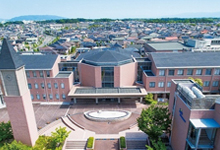A research team at Kio University (including Shiori Iwasa, a fourth-year student in the Department of Physical Therapy, Ryo Akakuchi, a doctoral student, and Professor Shu Morioka) is collaborating with Setsunan General Hospital to investigate how patients with progressive spinocerebellar degeneration can move to a wall. We showed that by using a light touch, it is possible to learn to maintain a stable standing position without excessive muscle contraction.
Spinocerebellar degeneration (SCD) is a progressive disease whose main symptoms are ataxia of the cerebellum and dorsal cord. SCD patients have difficulty maintaining postural balance, and falls have been reported in many cases. Light touch is known as a means of reducing postural sway, but this is usually done with the fingertips and acquisition of appropriate sensory information may be difficult in SCD patients with limb ataxia, making it difficult to apply. It had not been done.
This time, we conducted physical therapy in stages over four periods (one week each) for an SCD patient in his 60s whose ability to stand and walk had significantly decreased. During the early and middle stages of the intervention, participants practiced maintaining a static standing position in a relaxed state with their bodies lightly touching the wall. In the latter stage, when the static standing position was stabilized, we practiced voluntary center of gravity movement and interjoint coordination using tools, and we also practiced walking as planned.
As a result, improvements in standing posture balance, ataxia, and activities of daily living (ADL) were observed, and the patient was discharged from the hospital in a state where he was able to walk independently using a walker. These effects were verified through analysis of muscle activity during postural sway and standing. It was confirmed that maintaining a stable static standing posture contributes to suppressing excessive muscle activity, which leads to dynamic postural balance practice.
The present results suggest that gradual intervention can produce significant physical therapy effects even in patients with advanced SCD.

